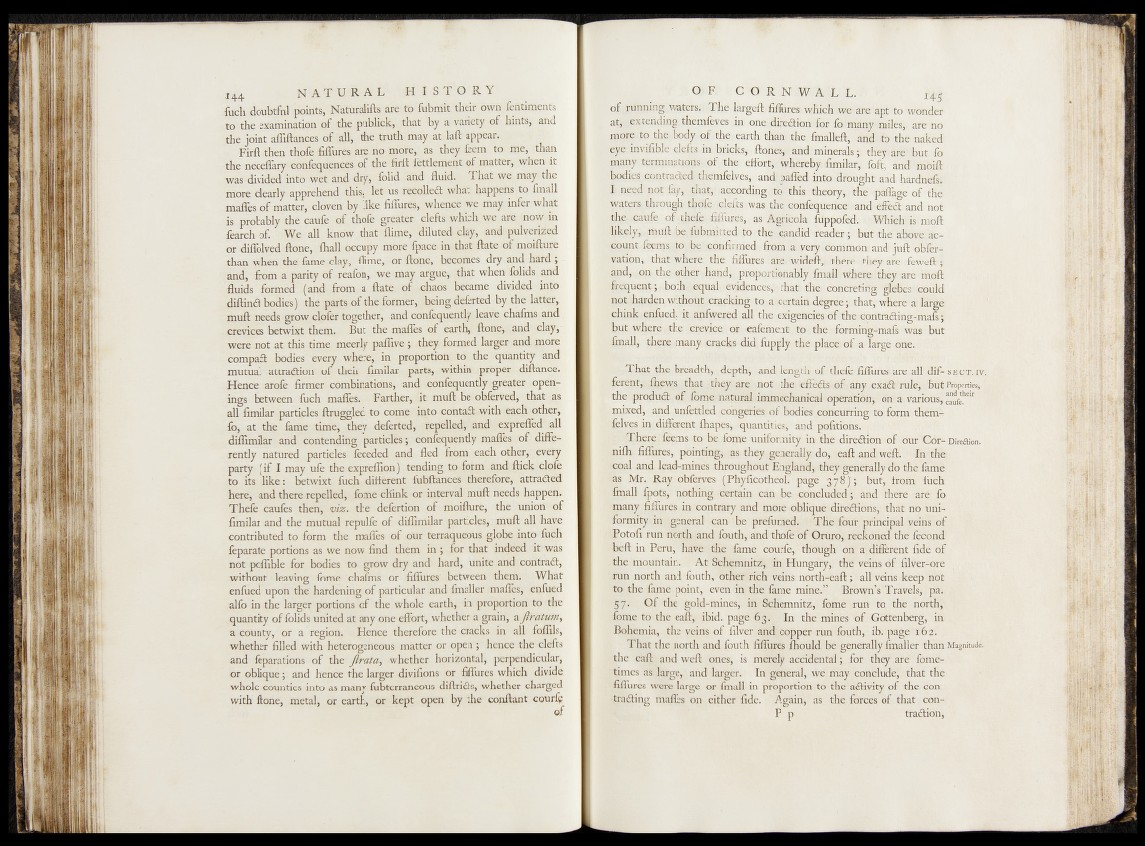
I g - N 'A ^ F T l R A L H I S T O R Y
fucli doubtful points, Naturalifts are to-fubmit their own Tenements
to the examination of the publick, Athat by a1, variety of hints,* and
the joint afliftances of all, the truth may,at.laft appear.
Firft then thofe'fiffures are no more, as they feem Wme, than
the neceflary -feonfequences of the firft iettlemeiit of matter,- when it
was divided into wet and dry, folid and fluids, That we may the
more clearly apprehend' this,^|e^us'fe^llea what happens to fmall
maffes of matter, cloven- by like fiffures, whence we may infer what
probably the caufe of thofe greater clefts which we ar^ mowin
fearch of. We all know that flime, dilbted- .elay, and* pulverised
or diflblved .ftone, ftiall occupy more fpace in, that ftate of moifture
than when the fame clay, flime, or ftone, hecoines dryland hard;
and, from a parity of reafon, we may argue, that when folids and
fluids £ormed (and from a ftate of-.chaos became divided into
diftind bodies) the parts of the former, being deferted by the latter,
muft needs grow clofer together, and confequentkjfeleave chafins.and
crevices betwixt them. But the mafles of earth, ftone, .and clay,
were not at this time meerly paflive-; they formed larger and^nore
compad bodies every where, in proportion tcft the quantity and
mutual attradion of their fimilar parts, within .proper-diftance.
Hence arofe firmer combinations, and confequently greater opbh-
ings between fuch mafles. Farther, it muft be obferved, that-^s
all fimilar particles ftruggled to come into contad^yith-?&ac|t 'Other,
fo, at the hme time, they deferted, .repelled, and'ft&fprefled all
diflimilar and contending particles; confequehtlymaaflfes of differently
natured particles feceded and fled from each other,-; every
party (if I may ufe theexpreflion) tending to-form ands flick - clofe
to its like: betwixt fuch different fubftances therefore, attraded
here, and there repelled, fbme clunk or interval muft needs happen.
Thefe caufes then, v iz. the defertion of > moifture, the union • of
fimilar and the mutual repulfe of diflimilar particles, ijtnuft all have
contributed to form the mafles of our terraqueous globe intoTikeh
feparate portions as we now find them in ; .for that indeed it? was
not poflible for bodies to grow dry and hard, Unite and: cont-rad,
without leaving fbme chafins or fiflures' between them. What
enfued upon the hardening of particular and fmaller mafles, eiflued
alfb in the larger portions of the whole earth, in proportion to the
quantity of folids united at any one effort, whether a grain, a Jlratum,
a county, or a region, Hence therefore the cracks in all foflils,
whether filled with heterogeneous matter or open ; hence the clefts
and feparations of the Jirata^ whether horizontal, perpendicular,
or oblique;, and hence the larger divisions or fiflures which divide
whole counties into as many fubterraneous diftrids, whether charged
with ftone, metal, or earth, or kept open by the copftant courfp
O F C O R N W .A L L. f g |
of running waters. The largeft fiflures which we are apt. to wondef
at, extending themfeves in one diredion for fo many miles, are no
ipqp^to the body of .the .earth than the fmalleft, jmd to the naked
eye invifible clefts in bricks, ftones, and minerals; they are but fo
mariy termina tfotis^ofe ffor^whereby fipjlaryffoft, and moifl
bodies contracted themfelves, and paffed into , drought and hardnefc
If need not fajy| that, ia^^t^ngslMf this * theory, ( thé pafiage of the
waters through thofe clefts was the confequence and effed and not '
the caufe of thefe fiffures, - as Agricola fuppofed. Ï\ Which is' moft
likely^rpdft be/fknitted to thc^lidid • reader; but thk above; account
. feems to, be confirmed, from a very common and juft obfer-
vation, that: where, thd fiffrires aftv widefft there they are deweftf
and, on the other hand, proportionably fmall where they are *rnoft
ftequent;- botjatójuaftèyidences^that' thy concreting glebes could
not. harden w ft^^crackfng to . ascertain degree ^that-,- where a Idrgé
chink^nfued, it anfwered all the exigentids.of thetpontrading-mafsf
■ jb^t .wfterepthe .creyice , or eafoment to* thc'Tormriigfmaft was but
ftnali, therefiqany .cracks did fupply the plocftof a ïftg ë one. •
.„T h a t the breadth,,depths’and length of thefe.fiffuresfjairedalBdif- spqr.rn
ftrent,-.fftews, tljat :they are not the effèéts of'any exad rule, but Properties,'
the produd'.of fome natural immechanical operation, dhfal variotisf)
mixed, aryLunfomed congeries of bodies concurring tórform‘ thdm-
t e y |sr in different fhapes, ^quantities; and pofitions.
feems to be fome uniformity in thg diredtion t oftfour 'Cór- Direction,
nifli. fiffures, pointing, as they generally do„aeaft anchweft. In tffo
coal and. lead-miries- throughout England,' theftgenerallyfto the fame
; as Mr. Ray obferves (Phyficotheol. page 378#^ But,;.T^i|]Tuchi
Igfrall ,fpots, nothing certain cafn ibe^eonclridedi; and thére rare* ft). '
■ many^fiffures in contrary and more oblique diredions,'- that rib uni-
formity in :generfl can be prefumed. tj The four principal yeifis.of
||fotofi run north and fouth, arid thofe of Oruro, reckoned %te' fecond
beft in Peru, nave the fame cotxrfe, though on' a&dmèrent fide ó f
the mountain^ At Schemnitz, in< Hungary, the veins o f filver-ore
run north and fouthjFother rich veins noftffteaft; all veins keep: rifrfe
to the fame; point, even in the ftme mine.” Brown’s'Travels, pa.
57. Of the gold-mines, in Schemnitz, fome .run to the nortïftt '
fome to the eaft, ibid, page 63. In the mines of Göttenberg, in
Bohemia, the veins of filver and copper run fouth, xb. page 162'.
That the north and fouth fiflures fhould be- generally fmaller than Magnitude,
the eaft and weft ones, is merely accidental; Tor they are fomft?\
times as large, and larger. In general, we may conb]ude^< that the
fiffures were large or fmall in pfpportion ito» tlie'adtivity of the con-
-trading mafles on either fide. Again, as the forces of . that con-
P p tradion,